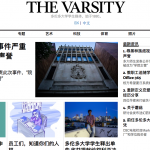Will people pay for hyper-local news?
This story was funded by the J-Source Patreon campaign.
For a paperless publication, the Sooke PocketNews is nearly perfect – on paper. It covers everything going on in the region, from the minutia of city council meetings to the weekend events in town to the latest highway closures. It publishes plenty of pieces every day, and on a good day it reaches nearly half the residents of Sooke.
And yet early in its fourth year, it needed to run a $10,000 fundraiser to keep publishing.
The Greater Victoria area—13 municipalities spanning out from the City of Victoria at the island’s tip—prides itself on being community-minded. In the city core, neighbourhoods are stocked with painted telephone poles, front-lawn libraries, rentable bikes, murals, and local festivals. There are block parties for streets that aren’t even a block long.
“The demographics here are perfect for a newspaper,” said Victoria Times-Colonist publisher and editor-in-chief David Obee in January after a set of layoffs. He cited the older population of the Saanich peninsula and other factors as reasons he felt the paper could sustain itself long-term without further cuts.
But do these apparent advantages actually translate to sustainable support for local journalism?
Sooke PocketNews founder and publisher Britt Santowski put that question to the test when she launched the “Do or Die” fundraising drive in March 2018..
The PocketNews brings in 3,500 to 6,000 daily readers in a community of 13,000, and 1.7 million total visits a year, according to Santowski. In 2014 after being laid off from the local Black Press paper, the Sooke News Mirror, she decided to fill the void created by its reluctance to post all of its articles online. As a new web-only paper the PocketNews has been successful bringing in a large local audience, but it hasn’t been so successful bringing in revenue.
“I’ve been at this for four years and still not making minimum wage,” she said “It’s a tough go.”
The same internet reading norms that opened the door to her success have limited it. Readers are used to not paying for online news.
“I’m fighting against a mindset of ‘this is free and if we pay her she’s going to become the next Google millionaire,’” Santowski said.
The funding drive involved a push to sign up monthly donors, special offers to local businesses, and a final “secret auction” event. The goal was to keep the PocketNews running for another half year, and Santowski said many readers were surprised the site was in such need.
“People think that as long as it’s there every day it must be going alright.”
The drive succeeded with a 60-40 split between audience and business support, but it went down to the wire—the climactic auction brought in the final few hundred dollars needed.
Rather than going through that nerve-wracking process again, Santowski has shifted toward paying her bills through a part-time job at Royal Roads university while running the site. If a lucrative enough full-time job offer comes along, she’ll look to sell or license out the site to someone interested in keeping it going.
A hard road to sustainability for small media startups
Santowski’s position is troublingly common for local independent newsmedia—providing an important service, appreciated by an audience, but unable to make enough to be sustainable. When chain papers withdraw coverage from local markets to cut costs, local alternatives step in to fill the information void, but often no money flows in to support the service.
On the island, Black Press’s purchases in 2010 and 2014 of Glacier Media papers and subsequent shuttering of those in competition with existing Black Press papers has reduced the number of different mainstream publications covering local news.
According to Jaigris Hodson, a media researcher and the head of the Interdisciplinary Studies program at Royal Roads in Colwood, large publications with local branches aren’t enough to serve regional news markets since most of the content is centralized. Small and independent local outlets are then crucial to providing the coverage relevant only to the immediate area.
“That they sometimes struggle, to me, means two things,” Hodson said “One: we haven’t recognized the value of these local news providers, and two: we can’t run the new local news ecosystem based on old legacy business models.”
Those legacy models’ failure to translate has produced many cases like Santowski’s on the island—publications sustained by the passion of core staff or a single founder rather than by a steady funding stream.
“It would be great to do this as my job but but I haven’t figured out how to do that yet,” said Quinn MacDonald, editor and owner of Victoria-based urban agriculture magazine Concrete Garden. Macdonald works full-time in public service as a day job and pays Concrete Garden’s editors, writers and artists but not herself.
Concrete Garden began as a University of Victoria class project but was spun off into a standalone publication. When MacDonald took over in 2014, she made the magazine for-profit due to the amount of funding and infrastructure needed to set it up as a nonprofit. She looked into the federal Canada Periodical Fund but was ineligible since she was keeping the magazine free due to logistical and accessibility concerns.
“I’ve been really poor and $5 makes a difference, and I want people to be able to read the magazine if they care about it. I see it as kind of an educational thing, so I don’t want to cut people off from it.”
She won a business plan competition that awarded $4,000, and since then has sustained Concrete Garden through print advertising, subscriber donations and help from other local orgs. UVic’s writing department does some in-kind exchanges, and local brewery Hoyne hosted and matched a customer donation box. But most local entities prefer offering verbal support rather than financial.
It isn’t only readers whose expectations are warped by cheap online standards. MacDonald feels that sponsored content has become so normalized that businesses constantly push for advertorials rather than just buying ads. And Santowski finds that advertisers overemphasize clicks as a metric because Google and Facebook use it, despite local media ads traditionally being more about generating awareness than immediate online purchases.
Both entrepreneurs struggle to balance the editorial and business aspects of their small publications—an issue that has come up even with larger and longer-established media in the island’s smaller communities. (The Cowichan Valley Citizen was accused this summer of pivoting away from coverage of a local racetrack’s noise issues after the track pulled ads.)
When finances are stronger both MacDonald and Santowski hope to hire advertising managers to avoid personally pursuing ads from local businesses they may also have to cover. Santowski is wary of the leverage businesses gain when their contracts can make or break a publication, and her hope long-term is to be primarily subscriber-supported.
“At a very core grunt level I would rather be accountable to 1,000 shareholders each paying three bucks a month than 10 businesses paying 300.”
But she knows that for the average person in the area, an extra three bucks isn’t as easy to come by as it once was.
Competition for limited funds
A shift to community-supported models is often framed as the solution to journalism’s post-print revenue problem, but it only works if the community has money to give.
While the south island may not be a poor area, it’s an increasingly unaffordable one. In the region and especially the capital city itself, recently skyrocketing rent prices have left the public scraping by and storefronts empty as incumbent shops are ousted to open the space for tenants who will pay a premium. This impacts both the main media revenue streams: established local advertisers tighten their budgets, while readers have less disposable income.
“The cost of living simply has not kept up with income,” Santowski said, citing both the housing crisis and years of multi-level government austerity.
“As a business owner you can say people need to support local and that’s all fine and well. But if you buy a tomato grown out in Metchosin it’s gonna be way more expensive than a tomato grown in California, and when you’re being governed by your finances you’re gonna make decisions that go against things that you deeply believed in.”
“There are these structural problems squeezing every part of our society” agrees Macdonald, noting that even the local businesses successful enough to not be displaced have been bought up by outside corporations.
“I say these businesses need to support us existing, but a lot of them are just trying to exist themselves.”
With both local advertising and local readers less able to fill the funding void than they’ve been expected to, publications may need to keep looking for a model, or combination of models, that can keep local journalism sustainable going forward.
Campus media explores supplemental crowdfunding
In the capital region, two long-running independent media organizations are finding some success with a blended model. At the 21,700-student University of Victoria, the community radio station and the student newspaper both turn to community fundraisers to bolster their pool of student funding and advertising.
After aging office equipment began faltering, campus paper The Martlet launched a GoFundMe in 2018 as part of its 70th anniversary. The levy has remained static at $3.75 per full-time student instead of increasing with inflation, ad revenue is always decreasing, and the paper now receives far fewer work-study hours than it used to from the university to subsidize its staff.
“The levy’s supposed to be enough to keep you stable but I don’t think it is,” said outgoing co-editor-in-chief Cormac O’Brien. “You have to be more creative because it’s worth less and less.”
Much of the model and guidance for the fundraiser came from the Martlet’s neighbour CFUV, one of the more successful campus community radio stations in Canada, bringing in $37,407 (at most recent count) in their latest funding drive.
CFUV has been broadcasting for a quarter century, but ramped up fundraising efforts two years ago under former station manager Johnnie Regalado by changing its approach.
“The idea was that people would only want to donate if they got a gift, and if you got rid of those people would stop donating,” said current CFUV Music Director and former volunteer coordinator Troy Lemberg. “The change in perspective was that people want to donate to us because they like the people that are here, the volunteers in particular, or they like CFUV—not because they can get something out of it.”
The station offered its individual donors CFUV-pride apparel instead of albums, directed its business sponsors toward discount ad deals instead of in-kind donations, and invested in staff and volunteers to work on fundraising year-round. While the tactical improvement increased the drive’s earnings from around $25,000 a year between 2009 and 2015 to $41,392 in 2017, corporate donations only represented 14 per cent of that peak total. Grassroots community support has formed the backbone of its fundraising efforts. Lemberg cites individual donors’ relationships to people in their lives who volunteer at CFUV and different communities’ relationship to the multicultural programming that represents them as the drivers behind the years of consistent support.
“The community views them as a necessity,” O’Brien said of CFVU.”You can’t just disappear for a year and show up in March and say, ‘hey, we’re asking for money now.’ They do such a good job of staying so present and active throughout the year that when its it’s time to fundraise it’s just a no-brainer. They really work for the right to ask for money back.”
The Martlet’s own GoFundMe campaign and anniversary gala brought in $2,800—enough for the needed equipment upgrades, but well short of its $5,000 goal and $10,000 stretch goal. With a few years to build, the newspaper may be able to emulate CFUV’s model. But for other publications in the region without campus media’s advantages of a built-in subsidy and a steady supply of volunteers, even the best crowdfunding push may not be enough.
Local media stability ties in to community health and wealth
“The subscriber-based model used in podcasting has great promise,” Hodson said. “But is not a complete solution on its own. We also need to consider non-profit and public funding of independent local news. This stuff is important enough for arm’s-length public funding.”
“As the Knight Commission has noted, there is absolutely a relationship between community health, wellbeing, democratic participation and access to locally relevant news. I can’t emphasize this enough.”
“Studies have shown both that areas with lower socioeconomic markers tend to be underserved by local news,” she said, explaining that poverty and news poverty feed into each other.
As with other public goods, those most reliant on the service are often the least equipped to pay for it. But they’re often also the most motivated to, as Santowski noticed during her campaign.
“It seemed to be that those who were in more financially precarious positions were the ones who gave even more generously,” Santowski recalled, and that generosity buoyed her faith in the campaign even at its more stressful points.
MacDonald kept Concrete Garden free so that it wouldn’t exclude that segment of the audience, and the fact her free magazine has subscribers choosing to pay for it reassures her that, despite her funding struggles, the community cares.
“We put in our magazine a {subscription slip} that you can cut out and put in an envelope and mail it to us,” explains MacDonald.
“And people do that, in 2018! They’ve got to be feeling something to do that. I get handwritten letters. I had one lady bring me a pie!”
Cam Welch is a writer, designer, and housing activist living in Victoria, B.C.



